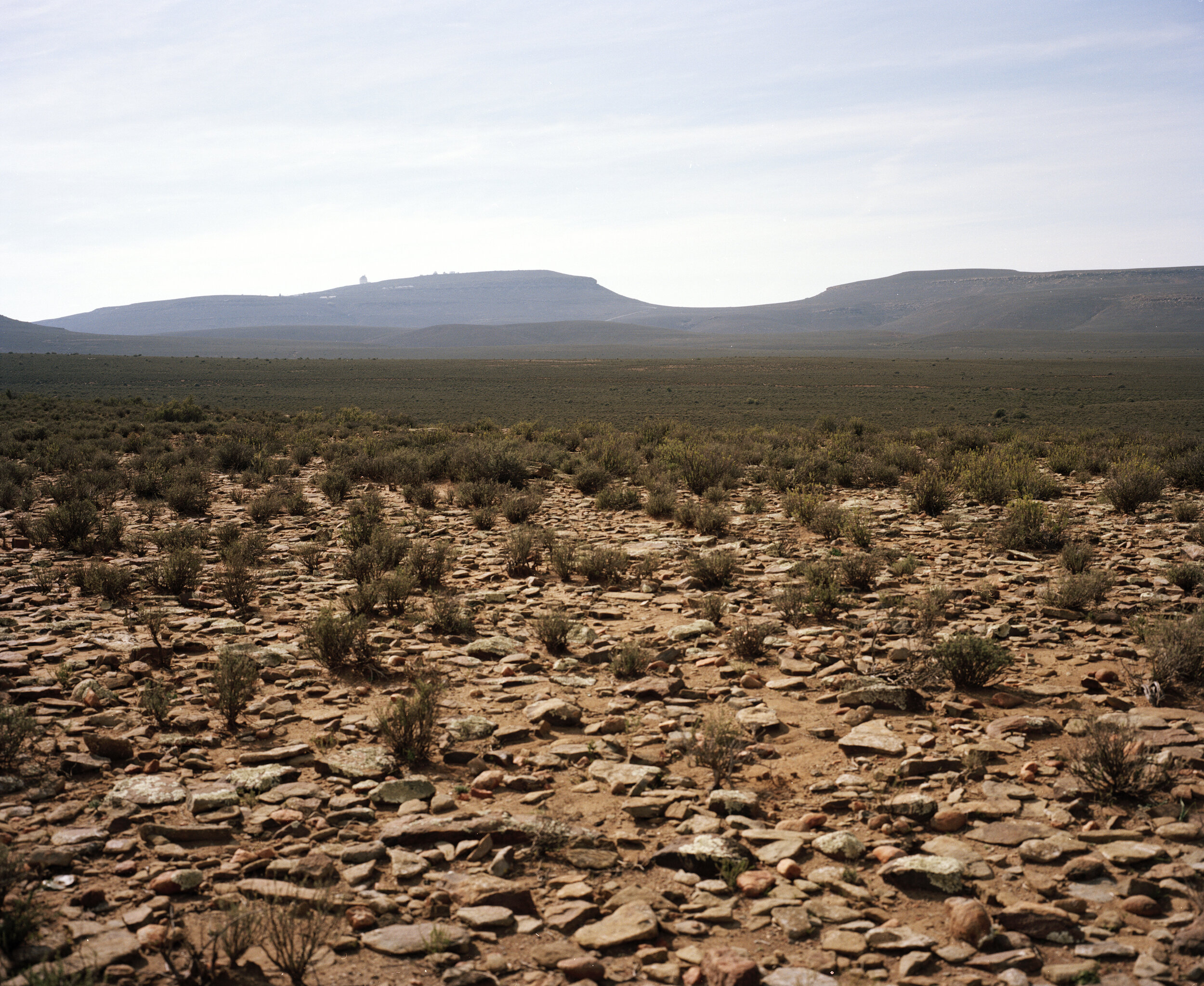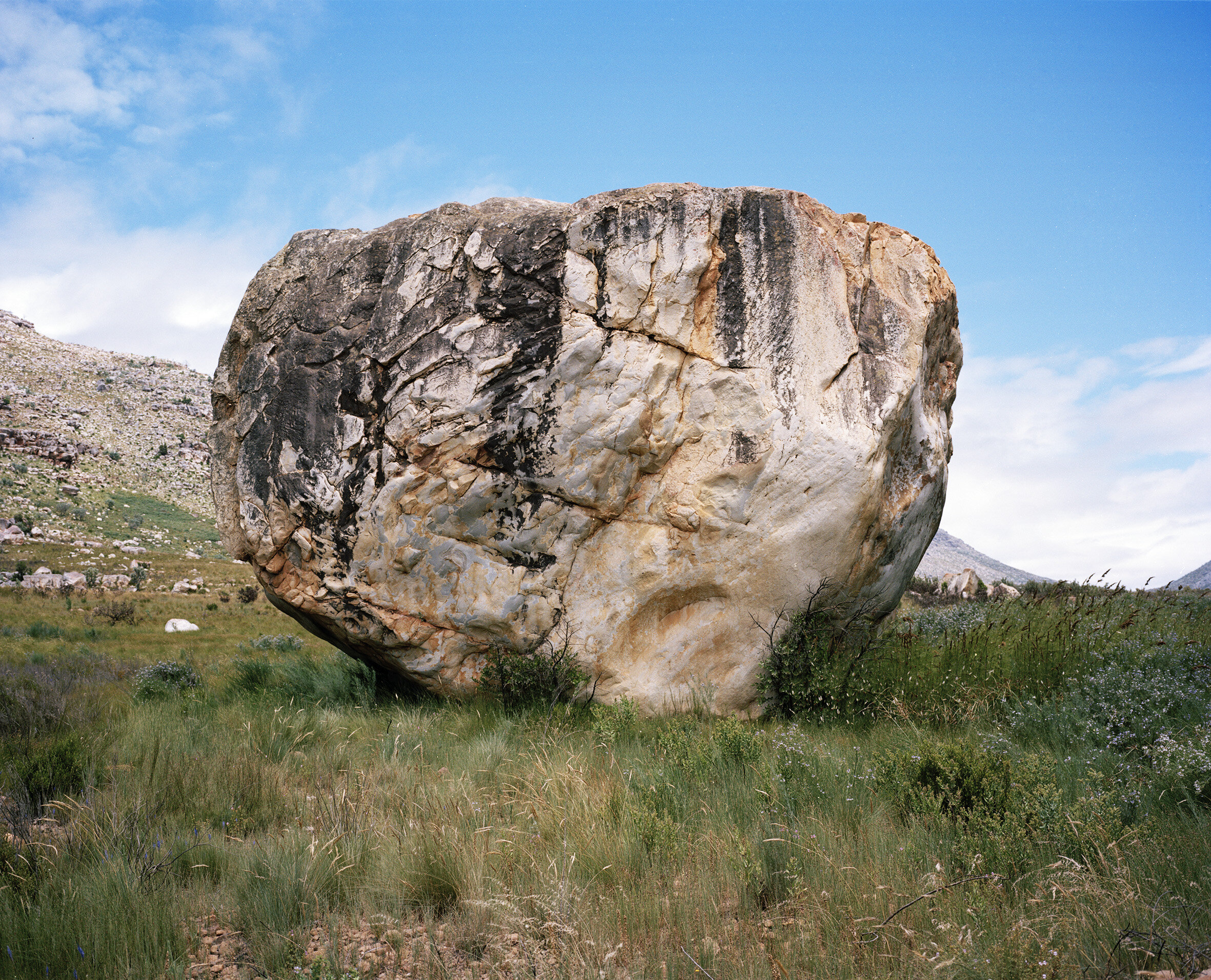KNERSVLAKTE (GNASHING PLAIN) # 2, NORTHERN CAPE
BETWEEN WILLINSTON AND CARNARVON # 2, NORTHERN CAPE
YSTERRANTE # 2 (NEAR THREE SISTERS) NORTHERN CAPE
KNERSVLAKTE (GNASHING PLAIN) # 1, NORTHERN CAPE
‘Knersvlakte’, literally translated from Afrikaans means “gnashing plain”. The name is said to originate from the crunching sound made by contact with the white, quartz-rich gravel. The quartz also reflects the sunlight, which makes the rocks and soil cooler in temperature than surrounding areas. This unique condition has allowed a large number of endemic plants to proliferate - many of these are small succulents that can absorb heat during the long and dry summers.
Read MoreBLACK ROCKS # 4, BETWEEN CALVINIA AND WILLISTON, NORTHERN CAPE
These rocks contain a high percentage of iron and their dark appearance forms a truly ancient landscape. The rocks make a metal sound when played; they are referred to with different names such as ‘rock gongs’, ‘ringing rocks’ or even ‘bushman pianos’. Found in various areas around the world and Africa, tradition formed around communicating with the help of the rocks - evident by the ancient drumming marks often found on them.
Read MoreLIEZEL HOFMAN AND THE ROCK ART DISPLAY , LIVING LANDSCAPE PROJECT, CLANWILLIAM, WESTERN CAPE
“For me, my identity is basically the person I’m accepting myself to be and who I believe I am. I don’t think I would identify myself as Xhosa or Tswana, I don’t think I would identify myself as coloured either. My father is coloured and everything in my genes I believe is more connected to an African lifestyle - which includes the Xhosa and Tswana. But currently, I’m the person I believe I am - that is my culture.”
Liezel is employed from twelve years in the museum of the living landscape project, that conceived around the idea of the Cederberg landscape as a time machine, that visitors can ‘travel’ through using the wealth of archaeological material continually discovered on site: structural remains, plants, animals etc.. the legacy of the San, the old Inhabitants of the area. The project looks at the astrological mythology of San people.
ROCKS GONG INSTALLATION, LIVING LANDSCAPE PROJECT, CLANWILLIAM, WESTER CAPE
TRUITJIESKRAAL CAVES # 1, CEDERBERG
SUTHERLAND, (THE ROAD TO THE SAAO OBSERVATORY), NORTHERN CAPE
STADSAAL CAVES # 2, CEDERBERG
TRUITJIESKRAAL CAVES # 5, CEDERBERG
METEORITE, PLANETARIUM, CAPE TOWN, WESTERN CAPE
'It was formed around the same time as our Sun and the Earth and after a leisurely tour of the Solar System as the centre of an asteroid, it came crashing down into southern Africa as the Gibeon Meteorite.
The Nama people used smaller bits of the meteorite for tools and countless chunks remained scattered over a large area. In 1836 Englishman J. E. Alexander collected samples and sent them to London. John Herschel confirmed they were indeed not of this planet.' *
TRUITJIESKRAAL CAVES # 6, CEDERBERG
BLACK ROCKS # 1, BETWEEN CALVINIA AND WILLISTON, NORTHERN CAPE
These rocks contain a high percentage of iron and their dark appearance forms a truly ancient landscape. The rocks make a metal sound when played; they are referred to with different names such as ‘rock gongs’, ‘ringing rocks’ or even ‘bushman pianos’. Found in various areas around the world and Africa, tradition formed around communicating with the help of the rocks - evident by the ancient drumming marks often found on them.
Read MoreBIG ROCK, CEDERBERG
BLACK ROCKS # 2, BETWEEN CALVINIA AND WILLISTON, NORTHERN CAPE
These rocks contain a high percentage of iron and their dark appearance forms a truly ancient landscape. The rocks make a ‘metal sound’ when played; they are referred to with different names like ‘rock gongs’, ‘ringing rocks’ or ‘bushman pianos’. Found in various areas around the world and accross Africa, tradition formed around communicating with the help of the rocks - evident by the ancient drumming marks often found on them. The rocks and the sounds they make were seen to have magical powers.
Read MoreSTADSAAL CAVES # 1, CEDERBERG
MARWA'S CAVE, (FROM JAN RABIE'S "DIE HEMELBLOM" 1971), TRUITJIESKRAAL, CEDERBERG
'For real, that is not a shadow, but an upright being squeezed up against the edge. Kind of like a human form with two arms and legs, a narrow, oval face framed by a cap looking like a bare skull, clothed in a blue overall that they only had a glimpse of previously. Dead quiet. Francois lowers the torch, lifts it again. One thing is for sure: this being is just as afraid as they are.'
From Die Hemelblom (The Heavenly Flower) by Jan Rabie, 2nd edition 1974, Tafelberg, first published 1971. Translated from the original Afrikaans by Nic Grobler.
The first encounter with Marwa, the main alien character in Die Hemelblom takes place in a collapsed cave near the Cederberg - she takes hands with the humans as they search for the a way out together.
Read More


















